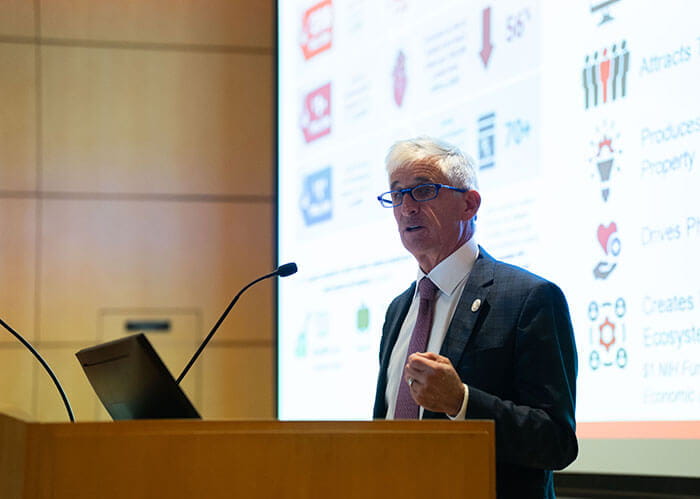Robust Research Growth and Continued Innovation Position University Hospitals at the Forefront of Transformative Clinical Care and Ground Breaking Science
May 01, 2025
Innovations in Research | May 2025
Over ten years ago, University Hospitals (UH) Harrington Heart & Vascular Institute participated as the core imaging laboratory for the first clinical research trial of HeartFlow Inc.'s FFRCT technology - a non-invasive, AI-driven technology that creates 3D models of coronary arteries to help physicians detect and assess blockages. In 2016, UH performed the 1st FDA-approved clinical case in the United States. Now, validated by many subsequent studies globally, HeartFlow is poised to become a new standard of care for coronary artery disease (CAD), the world’s leading cause of death. A study published in Nature Medicine in April 2025 confirmed its diagnostic safety and benefit.
 Dan Simon, MD presents the 2025 State of UH Research.
Dan Simon, MD presents the 2025 State of UH Research.UH’s role as an early adopter of a groundbreaking technology like HeartFlow exemplifies how research propels medicine forward, offering the newest drug, device and cell-based therapies – for patients with limited treatment options. These are the types of breakthroughs UH researchers and clinicians strive for across all specialties.
"Research is how we will accomplish our mission to improve and reduce the suffering of patients in our community, nationally and globally,” Daniel Simon, MD, President, Academic & External Affairs and Chief Scientific Officer, Ernie and Patti Novak Distinguished Chair in Health Care Leadership, University Hospitals Health System, said in his remarks at the 2025 State of UH Research Address on April 8. He noted consistent year-over-year research growth and highlighted 2024 as a record year. In fact, UH Cleveland Medical Center now ranks 8th in the U.S. and 16th globally among academic medical centers, according to UK Brand Finance.
Research Growth and Innovation Across the System
In 2024, UH achieved a total research portfolio of $214 million, a 9% increase over 2023. Grant indirect rose 42% to $13.4 million, vital for sustaining key research infrastructure and supporting early-career investigators.
Key milestones include:
- 3,420+ active clinical research studies
- 1,400+ peer-reviewed publications
- 73 invention disclosures
- 171 patent filings
- Training support for 1,178 residents/fellows and 2,272 medical student clerkship and elective rotations
“These metrics demonstrate how research drives patient outcomes, attracts talent, generates intellectual property, and contributes to the biomedical enterprise that drives our local and regional economy,” said Dr. Simon.
Clinical Breakthroughs and Translational Science
The steady pace of research and innovation at UH has enabled many leading-edge clinical advances including:
- Ultra-Fast CAR-T platform (David Wald, MD, PhD)
- First trial evaluating fenofibrate for HPV+ cancers (Quintin Pan, PhD)
- Limb-sparing endovascular procedure (Mehdi Shishehbor, DO, MPH, PhD)
- EsoCheck™ & EsoGuard for esophageal cancer screening (Amitabh Chak, MD; Sanford Markowitz, MD, PhD; Joseph Willis, MD)
These advances stem from strong multi-disciplinary collaboration that spans from basic science to health services research. This is what UH continually builds upon to achieve groundbreaking discoveries, therapeutic target identification, and maximum clinical impact by leveraging advances across the research continuum – from basic, translational, clinical, and real-world implementation.
Strategic Collaborations Fuel Discovery
UH’s partnerships fuel innovation. Long-standing affiliation with Case Western Reserve University School of Medicine (CWRUSOM) continues to expand scientific capacity. In 2024, the CWRU-UH Strategic Leadership Committee awarded Collaborative Science Pilot Awards to five new research teams consisting of faculty from CWRUSOM basic sciences as well as UH clinical departments. The committee also successfully recruited and retained 23 faculty since 2021.
UH’s new partnership with NEOMED has launched two new centers:
- UH-NEOMED Hearing Research Center
- UH-NEOMED Neurodegenerative Disease and Aging Research Center
Global efforts include the Oxford-Harrington Rare Disease Centre, aiming to bring 40 new therapies to clinical trials over the next decade, as well as collaborations with the Technion-Israel Institute of Technology, National Taiwan University and Morgan Stanley Gift Cures.
Building Research Excellence
UH’s Radiology Institute, in partnership with CWRU, secured over $10.9M in PI-led grants and $16.3M in new awards in 2024. Researchers and physician-scientists in this area are working together to develop new algorithms to not only diagnose disease but prognosticate response to treatment using AI and advanced imaging techniques. Their research appeared in more than 99 publications last year.
The Urology Institute reported 102 active research studies, 119 journal publications, $33.6 million in total research funding (2021-2024), and $12.3 million in newly funded research, a sharp 173% increase over the $4.5 million in new research awards received in 2023.
Mentorship remains a central focus. Six early-career investigators at UH currently hold NIH K-level grant awards, and several have successfully transitioned to independent investigators, including Drs. Stephen Carpenter, Thomas Raffay, and Rui Wang.
“Transitioning from early career to independent investigator is a national challenge,” said Dr. Simon, “but at UH, strong faculty mentoring committees play key roles in guiding researchers successfully from mentored awards to bifurcated, independent research careers.
Laying the Groundwork for Future Success
To sustain progress, UH is focused on recruiting faculty, expanding revenue streams, and strengthening collaborations. As the journey of HeartFlow technology shows, innovation requires time and perseverance, but the payoff—saving lives and reducing healthcare costs—is well worth the effort.
“Research is hard work and requires resilience and perseverance,” Dr. Simon concluded. “But the impact we can make is truly incredible.”
Tags: Research


